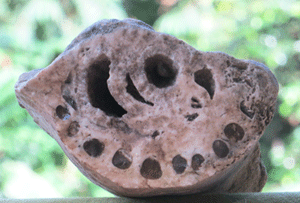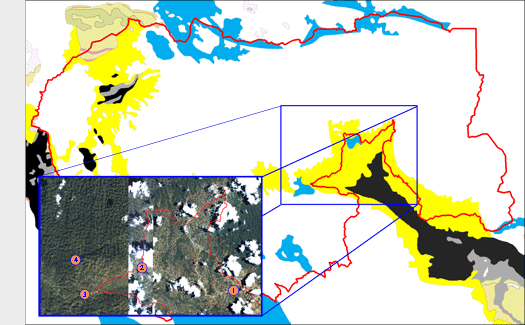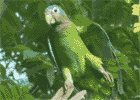
Character of the Month:
Jamaica: We've Had Our Ups-and-Downs...But the Rocks Keep Smiling
November 2014
We’re going on a grand tour of Jamaica through another dimension of time and space. No, you’re not in the Twilight Zone...well, you could be in Episode 54 from 1961... because we’re starting in the Jurassic Period, about 165 million years ago (MYA). Way back when dinosaurs were roaming around, Jamaica wasn’t much more than a blob of mud on the ocean floor. The crust of the Earth known as the “Proto-Caribbean Plate” was over in the Pacific, ~1000 kilometers from our current position, and Central America didn’t exist: North America and South America had already parted company from the supercontinent Pangea and they also were parting from each other. Panama didn’t connect them back until 3.2 MYA.
(Before going further, I’ll apologize to my geologist friends for what will be a gross simplification of the complex process of Plate Tectonics and for which there are still heated arguments on the bar stools.)
 With the movements of the Earth’s crust, the Caribbean Plate s l o w l y muscled its way eastward between North and South America and into the Atlantic Ocean.
At the leading (eastern) edge of the Caribbean Plate, and as a result of the North American Plate being forced sideways and downwards, a series of volcanoes (seamounts) developed.
As these volcanoes enlarged they rose above the water line – and the islands of the Greater Antilles made their first appearances.
With the movements of the Earth’s crust, the Caribbean Plate s l o w l y muscled its way eastward between North and South America and into the Atlantic Ocean.
At the leading (eastern) edge of the Caribbean Plate, and as a result of the North American Plate being forced sideways and downwards, a series of volcanoes (seamounts) developed.
As these volcanoes enlarged they rose above the water line – and the islands of the Greater Antilles made their first appearances.
We’re now in the mid-Cretaceous Period, about 100 million years ago, give or take a few million. Dinosaurs were still enjoying their global tropical sauna and our Caribbean neighbours of Dominican Republic, Puerto Rico, and the Virgin Islands were starting to stick their noses out of the water. The process of build-up via lava piles took millions and millions of years, but for a “brief” period of 5-8 million years the volcanoes were dormant. This gave plenty of time for deep- and shallow-water marine organisms to live and die, for sharks to lose teeth, for corals to create massive reefs – all before being pushed up above the water when volcanic activity resumed. What a marine biologist would describe as the skeletal graveyard of corals and fishes, a geologist would call beautiful limestone - calcium carbonate, sometimes with magnesium carbonate (aka dolomite) to give it a light tan or pink colour.
One of the most important reef-builders during the long Cretaceous Period was a group of bivalve molluscs called “Rudists”, like the one pictured above. I like Tony Porter’s description best: “...an abundant, gregarious population..these weird organisms, distantly related to present day clams...” were monster-size: some species grew to more than 2.5 meters (~ 8 ft) in length. As a community, they could form reefs which were hundreds of meters tall and often ran for hundreds of kilometers. Jamaica had its fair-share of Rudists, so that by 65 MYA, the island which had emerged from volcanoes and dead marine organisms, was available for occupancy by terrestrial plants and animals: we were up and open for business!
While the Earth's dinosaur residents were happily munching all the wonderously evolving plants which were literally blossoming from about 120 MYA onwards - the time when the plant class called Angiospermae (Flowering Plants) first appeared to take over from the conifers (Gymnosperms) - dumb luck catastrophe struck not once, but twice 65 million years ago. The first whammy came in the form of huge meteor, estimated to be about 10 kilometers in diameter and which smashed into Mexico’s Yucatan Peninsula. Had the Caribbean stayed in the Pacific, we wouldn’t have been quite so badly damaged. But unfortunately for the Antilles, we were probably only 1 to 3 crater diameters away for the Chicxulub impact site. Tsunami waves would have been more than one kilometer in height. Several thousand cubic kilometers of the Earth’s crust were vaporized, to slowly rain-down from the atmosphere as thick dust, smothering both terrestrial and shallow-water sendentary marine life.
The second whammy was a series of massive volcanoes which were erupting in India when the meteor struck. It’s been estimated that the volume of ash spewed from these volcanoes would have covered North America to a depth of nearly 200 m (600 ft). With tsunamis, choking toxic dust, and plunging temperatures associated with the dust in the atmosphere blocking-out sunlight, it’s thought that most life on the Antilles perished. Certainly, that was the unfortunate fate of the dinosaurs – those “Terrible Lizards” which thrived for about 165 million years -- and the Rudists -- remember those happy clams? Their tombstone is a layer of iridium and ingimbrites – a type of rock which results from the welding together of an accumulation of white hot ash particles.
Catastrophe for dinoasaurs and rudists, yes. For Jamaica, no. Post-meteor, the old rock we’ll call “Jamaica Soon Come”, was still getting a breezy, free-ride on the Caribbean Plate, continued to muscle its way eastward, cruising along at about 2 cm per year.
But suddenly, catastrophe really did strike. That’s “suddenly” as a geologist would say when something occurs over 20 million years: we found ourselves sinking under water! Corals and molluscs soon anchored in the shallow waters, fish were born and died, sharks continued losing teeth: new limestones were being created on the submerging island. For a while (say 5-10 million years) the still-exposed land areas were subjected to the eroding forces of wind and rain: the gullies carried the fine sediments out to sea to settle on the reefs. Today we call these “dirty reefs” Yellow Limestone.
 Once Jamaica was completely submerged (say 55 – 25 MYA; tho’ we might have been exposed “briefly” about 32 MYA when sea levels dropped 160m),
the limestones deposited in the shallow, and then deeper waters were no longer exposed to terrestrially-derived “impurities”. We call this uncontaminated pure limestone,
White Limestone. Needless to say, anything living on the island which couldn’t adapt to being totally submersed in salt water died-out. One such resdient which met that
fate was a little tapir-like animal belonging to the genus Hyrachyus, whose teeth got fossilised about 45 MYA.
I'm sure it stopped smiling as its island-home disappeared beneath the waves 😢
Once Jamaica was completely submerged (say 55 – 25 MYA; tho’ we might have been exposed “briefly” about 32 MYA when sea levels dropped 160m),
the limestones deposited in the shallow, and then deeper waters were no longer exposed to terrestrially-derived “impurities”. We call this uncontaminated pure limestone,
White Limestone. Needless to say, anything living on the island which couldn’t adapt to being totally submersed in salt water died-out. One such resdient which met that
fate was a little tapir-like animal belonging to the genus Hyrachyus, whose teeth got fossilised about 45 MYA.
I'm sure it stopped smiling as its island-home disappeared beneath the waves 😢
Jamaica may have been down...but don’t count us out just yet! After holding our breathe for 30 million years while limestones of up-to one kilometer thick were being formed -- those smiling sharks were still losing their teeth -- the island slowly re-emerged until, about 12-10 MYA, we were back up, fighting fit with our central plateau of proto-Cockpit Country. The Blue Mountains to the east were a little bit slower and were only uplifted between 5-10 MYA.

The oldest exposed rocks of Jamaica are found in the Central Inlier, in the south / southeast corner of Cockpit Country. If you started a journey in (1) Wait-a-Bit on the Inlier and went west through (2) Warsop to (3) Troy and then started to amble to Tyre and the start of the (4) Troy-Windsor Trail: First, I’d suggest you stop so you don’t get lost! Second, say “Wow!” In the distance of about 10-11 kilometers, you have experienced about 100 million years of history!
Our geologic history, coupled with the fact that since the final emergence 10 MYA, Jamaica has not been attached to the mainland – it is a true, oceanic island – has enormous consequences for the plants and animals which populate the island today. To get to Jamaica, you had to swim, fly, or raft in on some flotsam. Next month, will explore some flotsam, with “Mr. Mike’s Lizard-Green Jacket”.
| PREVIOUS CHARACTER | NEXT CHARACTER |

